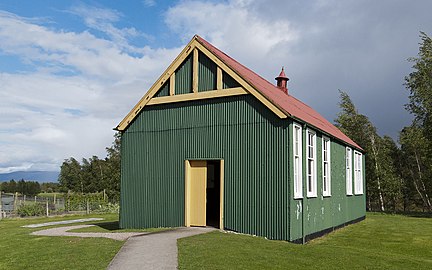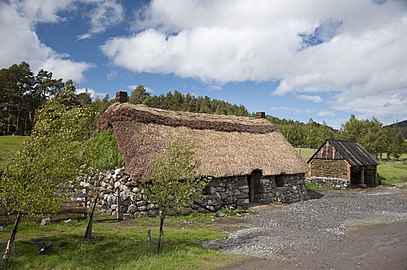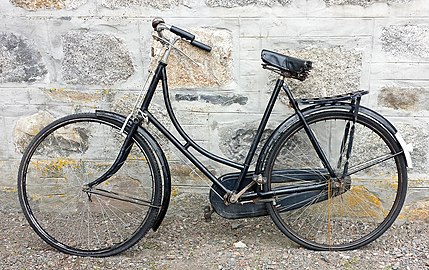Highland Folk Museum

The Highland Folk Museum is an open-air museum and visitor attraction by Newtonmore in Inverness-shire. It is the oldest open air museum in the United Kingdom, founded in 1935 by Dr Isabel Frances Grant (1887–1983). Today it is owned by the local council and administered by High Life Highland.
The museum contains an extensive collection of vernacular buildings, structures, implements and whole farmsteads intended to give a flavour of the way life was lived in the Highlands in past ages.
Exhibits
The museum is primarily made up of three areas that represent and interpret three separate eras of the Highlands.
- Pinewoods and Baile Gean Township in the west
- Balameanach / Middle Village, known as the ‘Open Air Section’ in the middle
- The Aultlarie Croft, a 1700s township, in the east of the park.
Open Air Section consists of buildings that reproduce built heritage from the nineteenth to mid twentieth centuries.[1]
The reconstructions in each area are supported by a staff member dressed and performing as a Highlander in the exhibit's setting, and on certain days, the museum features demonstrations of Highland life activities, such as weaving or rope making.[2]
While some of the buildings on the museum site were built there, many have been relocated from other places around the highlands and reconstructed onsite. In the early 2000s the museum acquired the Glenlivet sub-post office.[3] In 2011 a thatched cottage was recreated from a photo taken in the 19th century of a house that stood in Grantown-on-Spey.[4] The following year a crofthouse built in Carrbridge in the 1920s was donated and plans drawn up to move it 22 miles to the museum.[5]
-
Knockbain School, located in the Open Air Section
-
In the museum
-
Daluaine Summerhouse, located in the Open Air Section
-
1930s Raleigh lady's loop frame bicycle
History
In 1930, Dr Isabel Frances Grant organised and curated the 'Highland Exhibition' in Inverness, with 2,100 artefacts gathered and exhibited as a 'national folk museum'.[6] She founded the Highland Folk Museum in 1935, using a personal legacy to acquire a disused former United Free Church on the island of Iona;[6][7] Grant recorded 800 visitors in the first summer of opening and 900 the following year.[8]:553
Nicknamed Am Fasgadh (Gaelic for ‘The Shelter’), the Highland Folk Museum's remit was “…to shelter homely ancient Highland things from destruction”,[9] and Grant collected assiduously to that end.
By 1938 the collection had outgrown its home. In 1939 the museum moved to larger premises on the mainland at Laggan in Inverness-shire. In 1943 Dr Grant purchased Pitmain Lodge, a large Georgian house, together with three acres of land near to the train station at Kingussie, about twelve miles east of Laggan, and on the 1st of June 1944 the Highland Folk Museum opened once again to the public.[9][7][10]
The collections at Kingussie were developed “…to show different aspects of the material setting of life in the Highlands in byegone days”[9] and included a range of objects: furniture, tools, farming implements, horse tackle, cooking and dining artefacts, pottery, glass, musical instruments, sporting equipment, weapons, clothing and textiles, jewellery, books, photographs and archive papers. The collection also included accounts of superstitions, stories and songs, and home-crafted items including basketry, Barvas ware and treen. The site at Kingussie also enabled Grant to develop a suite of replica buildings: including an Inverness-shire cottage, a Lewis blackhouse and a Highland but-and-ben.[9][11] These buildings and the use of ‘live demonstrations’ to interpret exhibits for visitors sealed the Highland Folk Museum's popular reputation as the first open-air museum on mainland Britain.[6]
When Grant retired in 1954, ownership of the Highland Folk Museum and its collections was taken over by a Trust formed by the ancient Universities of Aberdeen, Edinburgh, Glasgow and St Andrews.[12] In 1975, the council took over management. In the early 1980s an eighty-acre site was acquired at Newtonmore, three miles to the south of Kingussie, and work began to lay out four distinct areas. 'Aultlarie Croft' reproduced a 1930s working farm; Balameanach as a developing community of relocated buildings; the Pinewoods, created an area of forest with interlinking paths; and Baile Gean for reconstruction of an early 1700s Highland township.[11][13] The Newtonmore site opened to the public in 1987. Kingussie closed in 2007. In 2011, responsibility for the day-to-day running of the Highland Folk Museum and its collections was handed over to High Life Highland – an arm's-length charity.
Outside links
| ("Wikimedia Commons" has material about Highland Folk Museum) |
References
- ↑ "Highland Folk Museum Map". https://www.highlifehighland.com/highlandfolkmuseum/wp-content/uploads/sites/5/2014/10/Highland-Folk-Museum_Plan_2013_A4.pdf.
- ↑ "Heritage Action Days". Highland Folk Museum. https://www.highlifehighland.com/highlandfolkmuseum/heritageinaction/.
- ↑ "12 things the National Fund for Acquisitions helped Scotland collect". BBC News. 11 December 2013. https://www.bbc.co.uk/news/uk-scotland-25320699.
- ↑ "Highland Folk Museum cottage recreated from photo". BBC News. 4 April 2011. https://www.bbc.co.uk/news/uk-scotland-highlands-islands-12956344.
- ↑ "Carrbridge crofthouse to be dismantled and moved to Highland Folk Museum". BBC News. 7 December 2012. https://www.bbc.co.uk/news/uk-scotland-highlands-islands-20627049.
- ↑ 6.0 6.1 6.2 Grant, Isabel Frances. 'The Making of Am Fasgadh' (National Museums Scotland, 2007) (Foreword by Hugh Cheape)
- ↑ 7.0 7.1 "The Lady of "Am Fasgadh"". The Glasgow Herald: p. 3. 2 July 1948. https://news.google.com/newspapers?id=JGpAAAAAIBAJ&sjid=hJgMAAAAIBAJ&pg=4205%2C3260130.
- ↑ Carter, Laura (17 August 2017). "Rethinking Folk Culture in Twentieth-Century Britain". Twentieth Century British History 28 (4): 543–569. doi:10.1093/tcbh/hwx038.

- ↑ 9.0 9.1 9.2 9.3 Grant, Isabel Frances. Am Fasgadh: the Highland Folk Museum at Kingussie, Inverness-shire, MacLehose Printers, Glasgow 1945
- ↑ "An Editorial Diary: Am Fasgadh". The Glasgow Herald: p. 2. 10 June 1944. https://news.google.com/newspapers?id=1C41AAAAIBAJ&sjid=A6YLAAAAIBAJ&pg=2093%2C2176347.
- ↑ 11.0 11.1 "Highland Folk Museum". High Life Highland. https://www.highlifehighland.com/highlandfolkmuseum/history-of-the-museum/.
- ↑ Fenton, Alexander (ed.) and Mackay, Margaret A. (ed.). Scottish Life and Society (Volume 1): An Introduction to Scottish Ethnology (A Compendium of Scottish Ethnology), Birlinn Limited, Edinburgh 2013
- ↑ Clarke, Amy. "Constructing Architectural History at the Open-Air Museum: The Highland Village Museum of Nova Scotia and the Highland Folk Museum of Scotland" (in en). Society of Architectural Historians of Australia and New Zealand (SAHANZ): Open 2013 Conference Proceedings. https://www.academia.edu/3797145/Constructing_Architectural_History_at_the_Open-Air_Museum_The_Highland_Village_Museum_of_Nova_Scotia_and_the_Highland_Folk_Museum_of_Scotland.




